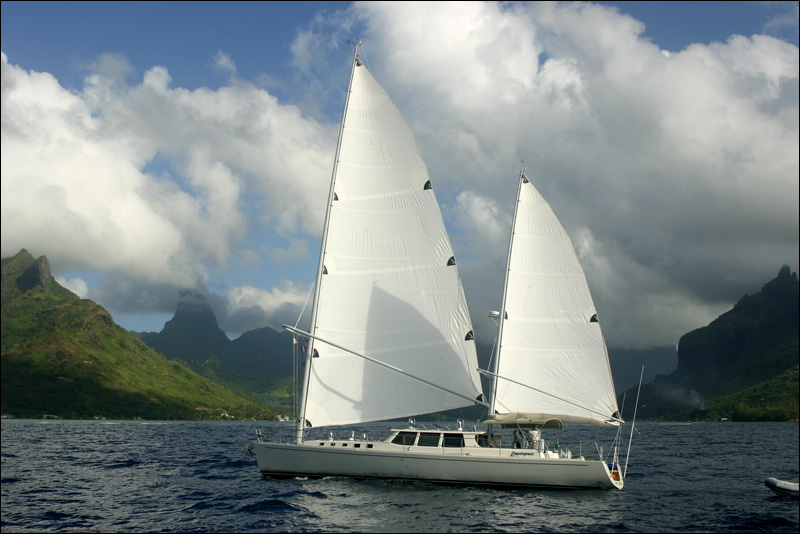 |
| CONVERGENCE under sail in front of Moorea (Photo taken by John Neal on MAHINA TIARI) |
A boat is as personal as a love affair. The relationship with one’s boat is subtle, personal, addictive. Like any relationship though, a boat takes time to figure out and work to maintain. The right boat can bring forth deep passion, evoke dreams, elicit freedom, stimulate self-reflection, build self-confidence, and depending on the vessel, reveal the humility or self-indulgence of the owners. The right boat can enable a life dream. The wrong boat can become a nightmare of problems and expense.
My husband Randy and I have both spent our careers in the marine industry. Being in the business of boat supplies, we have had the opportunity to look at thousands of boats at boat shows and in marinas all over the world. Collectively we have spent hundreds of hours talking to many experienced owners, designers, and manufacturers, asking tough questions along the way. When we had the good fortune to choose a cruising boat for ourselves, we did a lot of soul searching.
We are sailors. Yet for nine summers we cruised British Columbia to Alaska on a New England lobster boat. Our lovely green hull Duffy 42 is a single screw (one engine) powerboat. The hull was designed for lobster fishing off the coast of Maine, but it has a cruising cabin with all the amenities, two cabins, large head, and saloon and galley “up” which means we can see out the windows and drive from inside. The experience taught us about powerboating and a great deal about our powerboat customers.
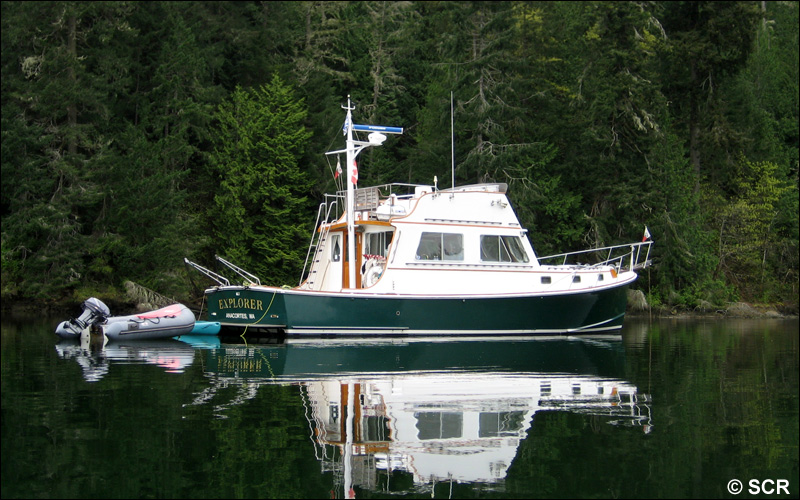 |
| EXPLORER – Duffy 42′ Lobster boat in Northern British Columbia |
For a time, long distance trawlers became one of our options for a cruising boat. But we could not change our stripes, we are sailors, and for open-ocean cruising we wanted the dual advantage of both power and wind.
Three goals shaped our decision in finding a cruising boat.
- We wanted to sail as a family, so it needed to be easy to handle for two people.
- We wanted comfort and efficiency.
- And we both wanted a fast boat.
While there are many wonderful boats out there, we did not find a production boat that completely met our needs or our long wish list of details. Disappointed but not deterred, we set out on the daunting task and two-year commitment of building a custom yacht.
Growing up sailing on the East Coast, Randy has always liked Cat Boats. (Catboats are usually beamy, wide hulls with a singe mast, which is carried forward in the bow.) Living in California he owned a Santa Cruz 33 and Santa Cruz 40, (Slender fast fiberglass race boats) so he also appreciated performance. I grew up sailing on the West Coast in a classic wooden boat, raced on performance yachts in the Northwest and had the opportunity to crew on various boats in a variety of places around the world. I wanted a boat that would be comfortable, sail well and get us there safely.
We chose to work with Tom Wylie, a talented San Francisco Bay area designer who is known for fast, innovative cat ketch rigged racer-cruisers with wishbone rigs on unstayed (no wires hold up the rig) carbon fiber masts. His boats are fast, easy to sail and unconventional. Frankly, it takes a while to get used to just looking at them. A giant wind surfer comes to mind.
While Tom Wylie designed the hull and rig, Randy and I designed everything else, the deck layout, the cabin, the interior and all her systems.
 |
| CONVERGENCE under construction, note window layout above nav station |
The end result is a very fast, reasonably comfortable, fairly easy to handle yacht.
Her length is 65’6”, with a 57’ water line, a 14’9” beam, 8’ draft and a main mast of 80’. At a svelte 39,000 lbs., her average cruising speed under power or sail is 8.3 knots or 200 miles a day. More often, she runs at 10. Her record speed surfing under sail is 22 knots; however, she may be capable of more in the right conditions. Her best run so far was 240 miles in 24 hours. Most of her innovations are common sense adjustments on traditional themes, a coming together of many ideas, hence her name: CONVERGENCE .
We worked with Westerly Marine, in Costa Mesa, CA, who manufactures quality custom yachts, including one America’s Cup boat. Convergence is simple and elegant.
 |
| CONVERGENCE splashes in 2004 |
From stem to stern she has clean lines. Unlike many cruising boats she has uncluttered decks. Even the windlass is below deck in its own compartment.
Rather than stanchions and lifelines, we designed tall stainless steel rails, which give an extra element of safety. Her exterior is easy to maintain. There is no wood on the exterior except for a wonderfully designed cockpit table, which hosts compartments for all the miscellaneous stuff that ends up there. Our canvas Bimini was eventually replaced with a hardtop over the cockpit to keep out the sun and the rain. The cabin top solar panels were exchanged for the WhisperGen™ heat and power system.
The saloon and galley are up. That means we are all together and able to see out the windows, a particular advantage for those who do most of the cooking. Large tempered windows (spec’d at jet cockpit window standards or able to take a frozen chicken at 500 miles an hour) offer complete visibility while maneuvering and allow us to take advantage of the view in beautiful anchorages.
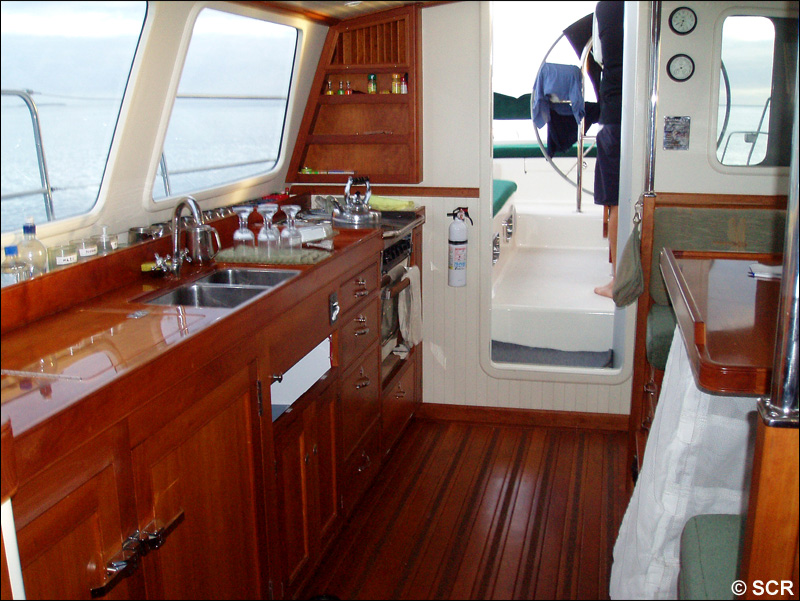 |
| Galley on CONVERGENCE Great view, lots of counter space, storage and easy access to cockpit. |
Our navigation station has a large desktop. All of the electronics and communications are laid out efficiently and surrounded by the windshield. You can see where you are navigating. The electrical panel is adjacent to the nav station for ease of checking all systems.
 |
| Nav station allows for plenty of visibility – in bad weather can steer from inside. |
The engine room has standing headroom, over an 8’ workbench and lots of storage. It is large enough to work in and if necessary to dry loads of laundry. Having a large designated engine room has many advantages. One is complete access to her 100-horse Yanmar engine, fuel filters, etc. We check our engine every day—on passages, every hour. We wanted it to be easy to access and to work on. Two underwater windows allow both keel and prop visibility and make it easy to see the bottom and fun to see sea life swimming by. We carry 400 gallons of fuel (70 gallons in the keel) and 300 gallons of tank water, along with a water-maker.
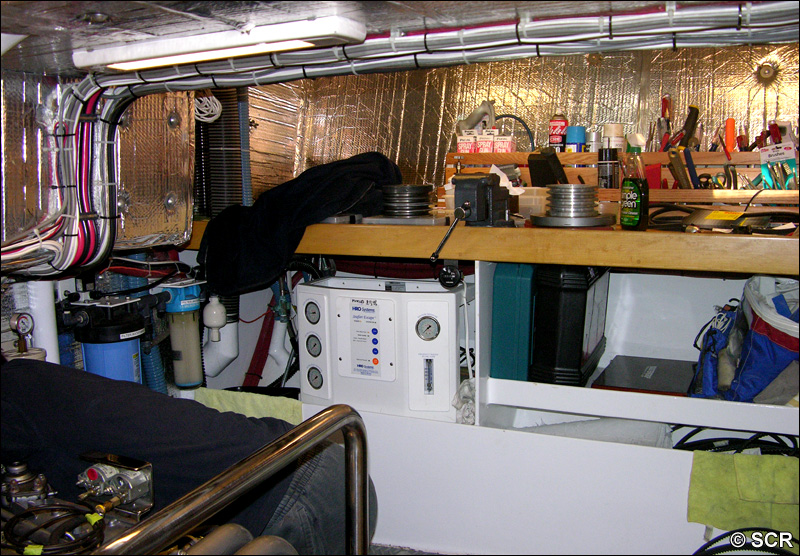 |
| Engine room with 8ft maple workbench and lots of storage |
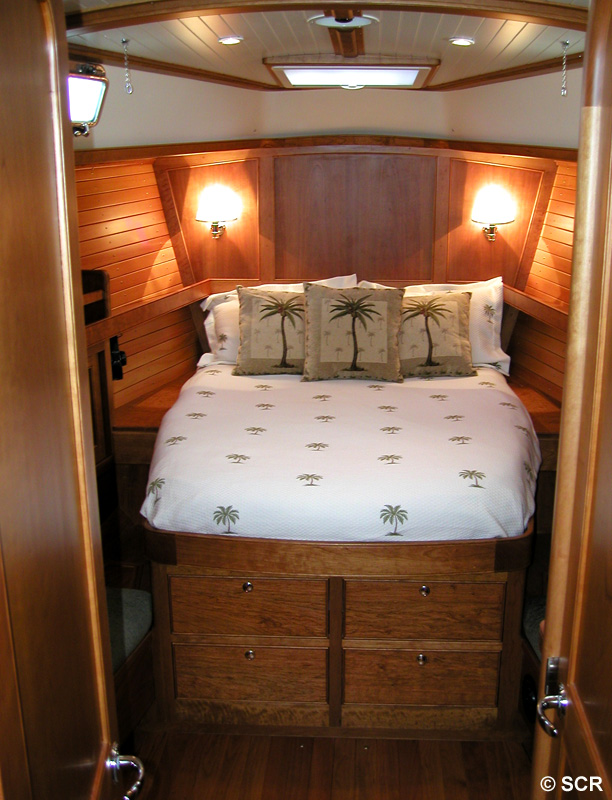 |
| Mistress cabin |
Convergence has comfortable accommodations, four cabins with 6’4”+ headroom, two with twin bunks and two with double bunks. Each of the cabins has hanging lockers, side tables, plenty of drawer storage and shoe lockers (something often lacking on a boat). The two heads are more than adequate, and have lovely hand painted ceramic sinks. Our showers have watertight storage for linens.
The woodwork is beautiful. We avoided rain forest woods and chose satin-varnished cherry with fine bone detail around traditional doors and cabinetry instead.
For its high tech materials and modern exterior, the traditional appointments on the interior are Bristol with nautical sensibilities. The fiberglass in both the interior and exterior is superb. We have a spacious cockpit, one that can accommodate a large party, and is very comfortable for fair weather sleeping.
The after deck, which we call the Beach Deck, is where we stow the dinghy underway, along with two kayaks, a dive compressor compartment and fishing gear. It is the perfect location for exercise at anchor, donning dive gear, setting out fishing lines or a time out. An outdoor shower allows for freshwater rinse of sandy feet, cleaning up scuba gear and moonlight bathing. Below the Beach Deck are large compartments where we keep dive gear, the swim ladder, an emergency tiller, cleaning supplies, numerous spares and other accumulations.
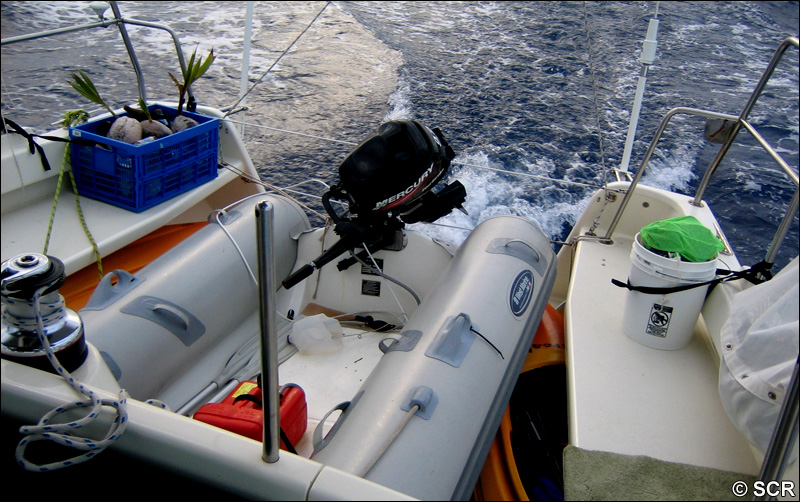 |
| Beach deck |
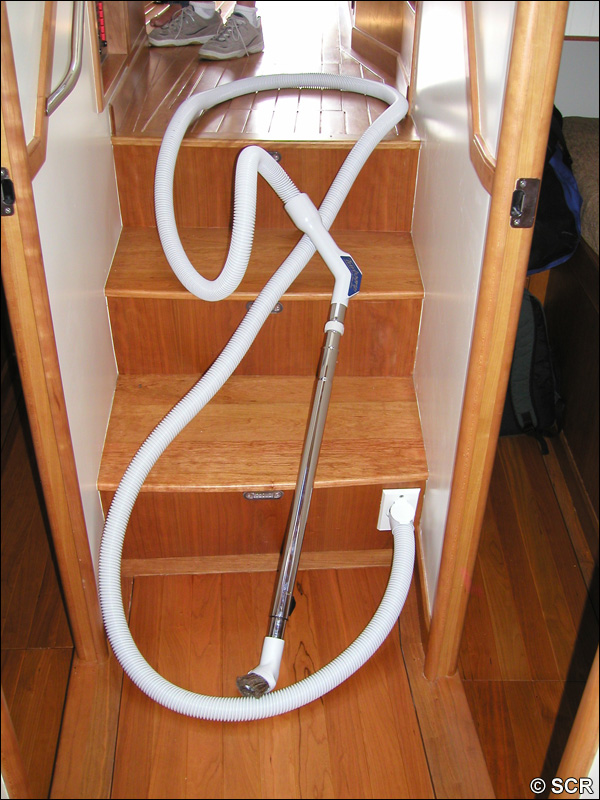 |
| Central vacuum |
Under the saloon, accessed by aft stairs, there is a full pantry. On port is a section with deep shelves and zippered screens for dry stores and condiments.
As I believe a clean boat is a healthy boat, we have a washer/dryer and a central vacuum with hose outlets that reach the entire interior and the cockpit.
There is easy, open access to fuel tanks, pumps, our inverter, water pumps, and the hot water tank. In addition, there is plenty of extra storage for drinks, bulk food stuffs and supplies in the balance of the pantry.
We carry no headsails, just large 80’ main and 60’ mizzen fully battened sails, each cut with lots of roach, which theoretically spills wind aloft, allowing us to carry more sail in higher winds. (To elaborate, main sails are rarely perfect triangles, the bottom edge is called the foot, the forward or leading edge, is referred to as the luff, and the after edge or back of the triangle is called the leech. The roach is the rounded shoulder of the sail, that extra sail cloth beyond the straight line from the top or head of the sail to the aft corner or clue.)
This means that we do not need to reef (shorten sail so as to not be overpowered by the wind) as soon as in more traditional rigs. From my point of view, reefing early, before the wind is too strong is the better part of valor. We installed electric winches, which make hoisting easy on our backs.
Convergence is fast, comfortable, and in inclement weather, we drive from inside.
 |
| Sally-Christine standing next to CONVERGENCE’s rudder (Photo by Randy Repass) |
We designed all of the systems to be efficient and reliable. However, all was not perfect in her construction. The most critical lesson we learned in building a custom boat was this: Regardless of the competence and trust you have in the boat builders, hiring a project manager who is specifically in charge of overseeing your project is essential and would have removed a lot of our headaches. A project manager who not only oversee progress, but is onsight regularly to ensure that those in charge of the installations know what they are doing and that all systems are tested, and working before you take delivery.
Most of the challenges we have faced have been the result of improper installations and in some cases improper specs by manufacturers. Critical failures due to confusing or inaccurate manufacturer’s specs or installer error in plumbing and electrical come to light at the most inopportune moments. Many of these issues could have seriously jeopardized the safety of the boat. They could have been avoided with a good project manager. Randy’s patience, skill and his innate ability to fix anything have kept us happily afloat.
We had another interesting issue, which was that we were bow down and surprisingly tender. This was corrected in a Raiatea boat yard by adding a two thousand pound shoe to the aft end of the keel bulb, which added stability and improved her ride.
Like building a house, building a boat requires lots of decisions, a budget, a sense of humor, and determination to get it done, and if necessary part of it redone. Randy and I both love projects. We like building things, and seeing them through to completion. Keeping our eye on the goal, having good communication, mutual respect and staying focused has helped us make the process a pleasure. Like our relationship, we nurture our boat, extol her virtues, and enjoy every precious moment we have aboard.
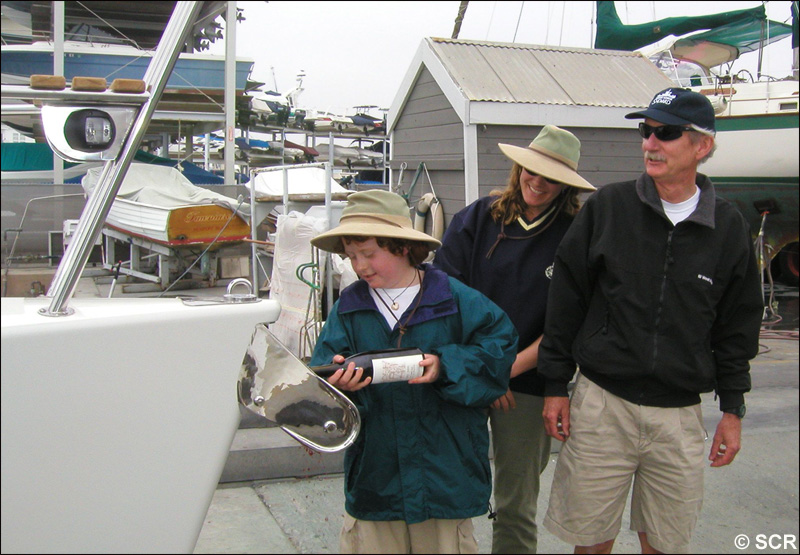 |
| Nine year old Kent-Harris christens CONVERGENCE with our R bar R Ranch Pinot Noir, Sally-Christine and Randy looking on. |
About Sally-Christine Rodgers
 |
| Sally-Christine and her family in the water (Photo by Peggy Repass) |
When she is not tending gardens, grooming horses, taming long horns or working on marine conservation, Sally-Christine Rodgers spends time writing about the other side of her life – cruising on Convergence.
Making their way around the world a section at a time, Sally-Christine with her husband Randy and son Kent-Harris extend each summer aboard their custom 65’ sailboat sharing observations and insights along the way.
How did you choose your cruising boat?
Let us know.
Email kathy@forcruisers.com or leave a comment below.


Sally-Christine! What a wonderful article about CONVERGENCE!
So very interesting and well written. I enjoyed, and agreed with, all you described so well.
I hope you continue to contribute to Women and Cruising. Your knowledge and enthusiasm will not only help other women but, more importantly, inspire them to become involved with their partners and their boats and their sailing.
Thank you!
Pam Wall
Sally-Christine,
What a great article! I enjoyed reading about your ideas for things I would never have thought of. Love the beach deck and the windows in the “kitchen”.
I wonder if you could comment on how your timelines and costs fared relative to estimates. I have always been loathe to build having heard the nightmares of overruns, especially on custom builds.
As I was reading, I also wondered about crossing oceans on Convergence. How did you find sleeping on a centerline queen while heeling in high winds? I’d love to have a centerline queen for convenience but having sailed through multiple gales in the North Atlantic, I have also thought that would be impractical. Did you find a solution?